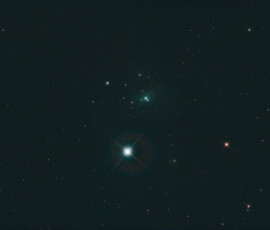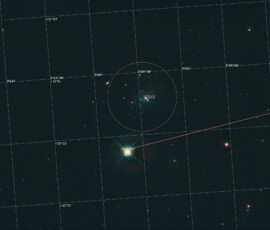IC 348 is a star-forming region in the constellation Perseus located about 1,000 light years from the Sun. It consists of nebulosity and an associated 2-million-year-old cluster of roughly 400 stars within an angular diameter of 20″. The most massive stars in the cluster are the binary star system BD+31°643, which has a combined spectral class of B5. Based upon infrared observations using the Spitzer Space Telescope, about half of the stars in the cluster have a circumstellar disk, of which 60% are thick or primordial disks.

IC 348
IC 348 is a star-forming region in the constellation Perseus located about 1,000 light years from the Sun. It consists of nebulosity and an associated 2-million-year-old cluster of roughly 400 stars within an angular diameter of 20″. The most massive stars in the cluster are the binary star system BD+31°643, which has a combined spectral class of B5. Based upon infrared observations using the Spitzer Space Telescope, about half of the stars in the cluster have a circumstellar disk, of which 60% are thick or primordial disks.
Photographed with the RC8″ reflector telescope and the ASI 2600MC color CMOS camera in Stuvsta, February 19th, 2025. Exposure was 30*2 min with IDAS GNB narrowband filter. Postprocessing in Pixinsight.

IC 348
IC 348 is a star-forming region in the constellation Perseus located about 1,000 light years from the Sun. It consists of nebulosity and an associated 2-million-year-old cluster of roughly 400 stars within an angular diameter of 20″. The most massive stars in the cluster are the binary star system BD+31°643, which has a combined spectral class of B5. Based upon infrared observations using the Spitzer Space Telescope, about half of the stars in the cluster have a circumstellar disk, of which 60% are thick or primordial disks.
Photographed with the RC8″ reflector telescope and the ASI 2600MC color CMOS camera in Stuvsta, February 19th, 2025. Exposure was 30*2 min with IDAS GNB narrowband filter. Postprocessing in Pixinsight.